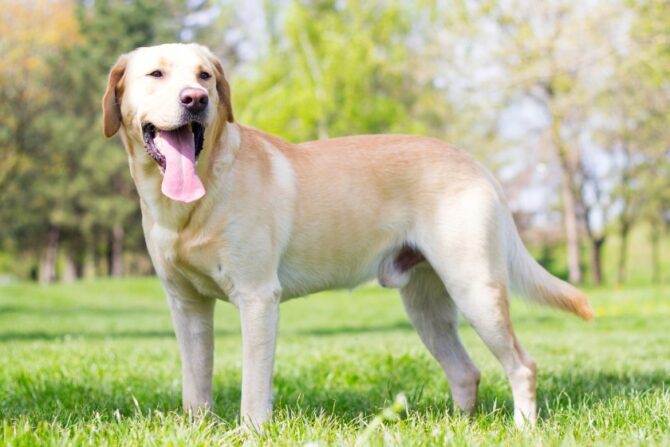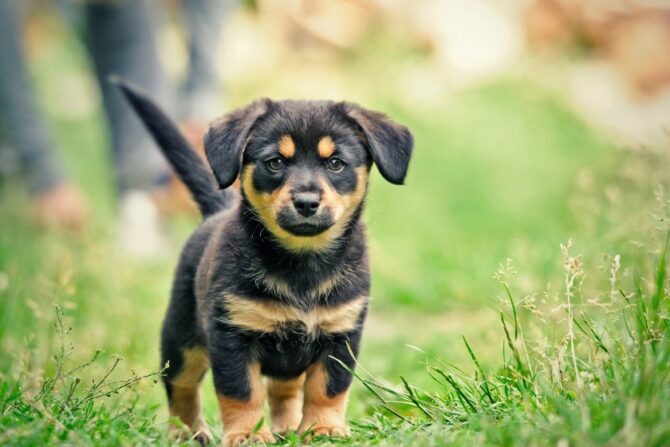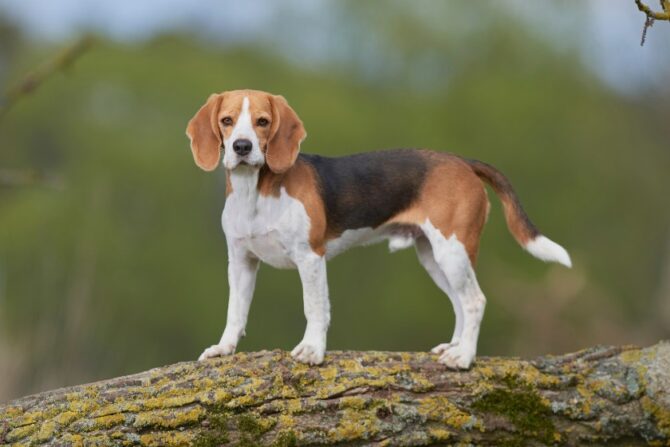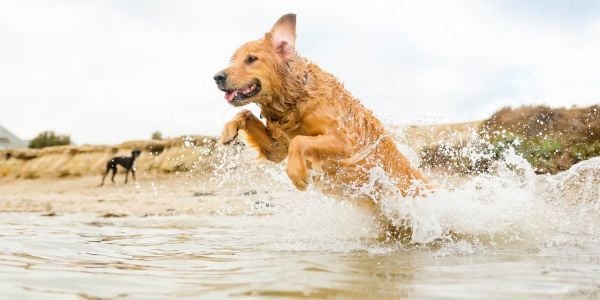Dogs are a man’s best friend and the most popular pets in the world.
They are known for their affectionate nature, loyalty, and ability to provide companionship and comfort to their human companions.
These canines have been domesticated for thousands of years. Some experts estimate that the first domesticated dogs appeared more than 15,000 years ago.
Today, they are more popular than ever, with millions worldwide welcoming these furry friends into their homes.
From small lapdogs to massive working breeds, these canines come in various shapes and sizes, each with unique personalities and characteristics.
This article will explore the world of dogs, from their basic anatomy and physiology to the many different extant breeds.
We’ll also cover topics like training, nutrition, health, and fun dog facts to deepen your understanding and appreciation of our canine companions.
Characteristics

| Common Name | Domestic Dog |
| Scientific Name | Canis lupus familiaris |
| Type/Classification | Mammal |
| Higher Classification | Wolf |
| Diet | Omnivore |
| Average Lifespan | 10 – 13 years |
| Size | 15 – 110 cm (5 – 44 in) at shoulder |
| Weight | 15 – 110 cm (5 – 44 in) at the shoulder |
| Gestation Period | 58 – 68 days |
| Group Name/Collective Noun | Pack, mute, kennel |
| Term for Young | Puppy, whelp, litter |
| Global Population | Approximately 900 million (2024) |

Origin and Evolution
Dogs (Canis lupus familiaris) are domesticated mammals that are believed to have descended from wolves.
The exact process of domestication is still a topic of scientific debate.
However, one theory suggests that it may have been a gradual process, with wolves gradually becoming more tolerant of human presence and less fearful over time.
Research on the genetic origins of dogs has shed light on the process of domestication.
Studies have shown that dogs are descended from a group of wolves that lived in the Middle East around 15,000 years ago.
These wolves were likely attracted to human settlements due to the availability of food scraps.
Over time, they began to tolerate human presence and even form social bonds with humans.
As humans began to selectively breed these wolves for desirable traits, such as a friendly disposition or a willingness to work with humans, the process of domestication accelerated.

Over time, these domesticated wolves evolved into the various breeds we know today.
Despite their evolution from wolves, dogs have many unique traits that set them apart from their wild ancestors.
They have a more diverse range of coat colors and patterns, and their skulls have become more domed and rounded than those of wolves.
Anatomy and Physiology
These canines are complex creatures with many biological systems that work harmoniously to keep them healthy and happy.
Below are the key elements of the dog’s anatomy and physiology:
General Anatomy
Dogs are quadrupeds, meaning they walk on four legs. Their basic body structure includes the:
- Head – made up of the skull, jaws, teeth, and sensory organs like the eyes, ears, and nose,
- Body – includes the chest, abdomen, and pelvic region,
- Limbs – includes the front legs, or forelimbs, and the hind legs, or hindlimbs,
- Tail – a flexible extension of the spine.
They also have various biological systems, such as the following:
- Respiratory system – includes the lungs and airways,
- Circulatory system – includes the heart and blood vessels,
- Digestive system – comprises the stomach and intestines.
Senses
Like humans, dogs have five senses – sight, hearing, taste, smell, and touch.
However, they have a much stronger sense of smell than humans.
Some breeds have up to 300 million olfactory receptors in their noses compared to roughly 6 million in humans, making them excellent trackers and scent detectors.
Their sense of taste is less developed than their sense of smell, but they still have preferences for certain flavors.
Skeletal Structure
The dog’s skeleton comprises approximately 320 bones, much more than the human skeleton, with 206 bones.
Their bones are designed to support their bodies and provide them with mobility and agility. The bones are held together by joints, which are critical for movement.
Muscular System
Their powerful muscular system allows them to run, jump, and play. Dogs have three main types of muscles including:
- Skeletal muscles – attached to bones and allow for movement,
- Smooth muscles – found in internal organs and help with functions like digestion,
- Cardiac muscles – found in the heart and allow for its rhythmic contractions.
Reproductive System
The reproductive system of male dogs includes the testes, which produce sperm, and the penis, which is used for mating.
The reproductive system of female dogs includes the ovaries, which produce eggs, and the uterus, where fertilized eggs develop into puppies.
Dogs reach sexual maturity at around 6 to 12 months and can reproduce throughout their adult lives.
Breeds

There are hundreds of different dog breeds in the world, each with its unique characteristics, temperament, and physical traits.
They are classified into different groups based on their size, function, and origin.
Understanding these different types of dog breeds can help you choose the right pet for your lifestyle and needs.
Popular Breeds

Some of the most popular dog breeds in the world include:
- Labrador Retriever: Labradors are known for their friendly nature and intelligence. They are often used as service and therapy dogs.
- Golden Retriever: Similar to Labradors, Golden Retrievers are affectionate and friendly canines that are often used in search and rescue operations.
- German Shepherd: Originally bred for herding and guarding, German Shepherds are highly intelligent and loyal companions that are often used as police and military dogs.
- Poodle: Poodles are a highly intelligent and trainable breed that comes in different sizes – standard, miniature, and toy.
- Bulldog: Bulldogs are breeds known for their friendly and affectionate nature. They have a distinctive appearance with their wrinkled faces and stocky build.
- Beagle: Beagles are a medium-sized breed known for their keen sense of smell and energetic nature. They are often used as hunting dogs and make great family pets.

Breed Groups
Dog breeds are classified into different groups based on their size, function, and origin. The American Kennel Club (AKC) recognizes seven breed groups, including:
- Sporting Group: Breeds originally bred for hunting and retrieving game birds. They are typically energetic and intelligent and enjoy being outdoors. Some popular breeds in this group include the Labrador Retriever, Golden Retriever, and Cocker Spaniel.
- Hound Group: They were bred for hunting, but they specialize in tracking and chasing game. These breeds have a strong sense of smell and are known for their endurance. Popular breeds in this group include the Beagle, Greyhound, and Bloodhound.
- Working Group – They were bred to perform a variety of jobs, including guarding, pulling carts, and search and rescue. These breeds are intelligent, loyal, and have a strong work ethic. Popular breeds in this group include the German Shepherd, Boxer, and Great Dane.
- Terrier Group – Terriers were originally bred to hunt and kill vermin, such as rats and mice. They are typically small and feisty, with a lot of energy and personality. Popular breeds in this group include the Jack Russell Terrier, Scottish Terrier, and Airedale Terrier.
- Toy Group – They were bred for companionship and were often kept by royalty and nobility. They are typically small and have a gentle disposition. Popular breeds in this group include the Chihuahua, Pomeranian, and Toy Poodle.
- Non-Sporting Group – Different breeds that do not fit into any of the other categories. They come in a variety of sizes and temperaments and were bred for a variety of purposes, including companionship and guarding. Popular breeds in this group include the Bulldog, Dalmatian, and Poodle.
- Herding Group – They were bred to help herd and manage livestock. These breeds are typically intelligent, energetic, and have a strong instinct to herd. Popular breeds in this group include the Border Collie, Australian Shepherd, and German Shepherd.
Living with Dogs

Living with dogs can be a rewarding and fulfilling experience, but it also requires a significant commitment of time and effort.
Dogs are social animals that require regular attention and care to thrive, and they can significantly impact your daily routine and lifestyle.
One of the most important aspects is providing them with a safe and comfortable living environment.
This includes providing them with a comfortable place to sleep, plenty of opportunities for exercise and play, and a healthy and nutritious diet.
They also require regular veterinary care to maintain their health, including vaccinations, parasite prevention, and routine check-ups.
Training and socialization are also important for canines. Puppies should be socialized from a young age to help them develop positive relationships with other animals and people.
Basic obedience training can also ensure the pup is well-behaved and responsive to commands.
There are also some potential challenges. Canines can be prone to certain health issues, such as obesity, dental problems, and joint issues.
They can also exhibit behavioral issues, such as separation anxiety or aggression, which may require professional intervention.
Living with a dog also requires a significant investment of time and effort. Canines need regular exercise, playtime, and attention and affection from their owners.
They may also require regular grooming and care, such as bathing and brushing.
Despite these challenges, they are loyal companions that provide love and affection and can also provide a sense of security and protection.
They can also serve as therapy animals, providing emotional support and comfort to their owners.
Fun Dog Facts
- Dogs have an incredible sense of smell, with some breeds able to detect scents up to 100,000 times better than humans.
- The Basenji is the only breed that doesn’t bark. Instead, they make a yodeling sound.
- Dogs have three eyelids, including one that helps to keep their eyes moist and protected.
- The tallest dog on record is a Great Dane named Zeus, who stood 44 inches tall at the shoulder.
- The smallest dog on record was a Yorkshire Terrier named Sylvia, who stood just 2.5 inches tall at the shoulder.
- Dogs can understand and respond to more than 100 different human words and gestures.
- The oldest dog on record is a purebred Rafeiro do Alentejo named Bobi, who is 30 years and 266 days old as of Feb. 1, 2024.
- Dogs can see some colors, but their vision is mostly limited to shades of blue and yellow.
- Dalmatians are born completely white, but they develop their spots as they grow older.
- Dogs have a special gland in their rear end that produces a unique scent, which they use to mark their territory and communicate with other canines.
Conclusion
Dogs are fascinating and beloved animals that have captured our hearts and homes for thousands of years.
From their evolutionary origins to the countless breeds and unique personalities, they’re a source of wonder and joy for people.








